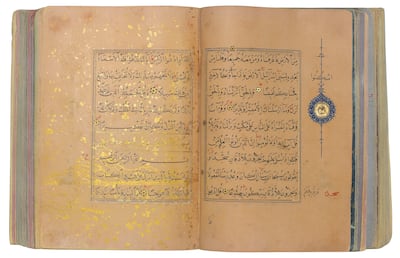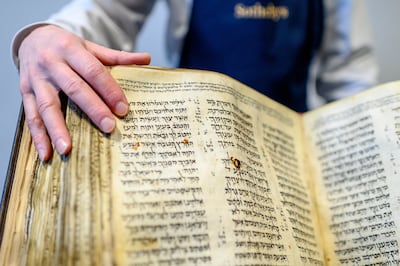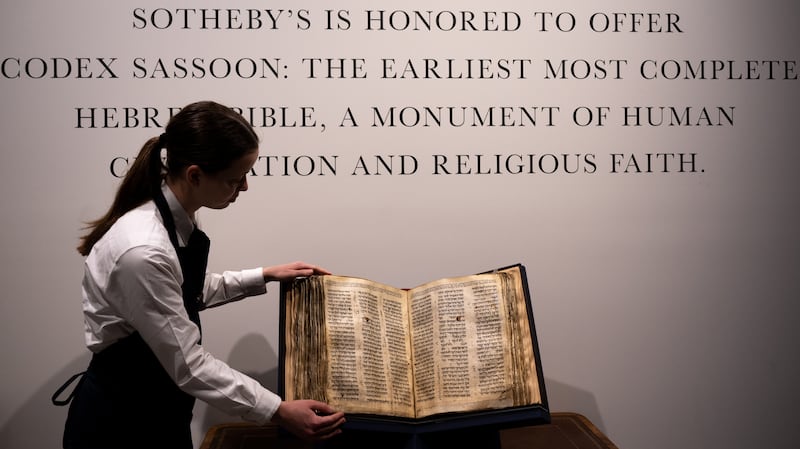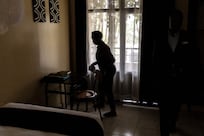One of the oldest books in existence will be sold at auction in June and is expected to fetch more than $2.6 million.
The ancient book from Egypt known as the Crosby-Schoyen Codex was written in Coptic on papyrus in about 250-350 AD. It was created in one of the first Christian monasteries, and according to Christie's auction house, which will be conducting the sale, it has an estimated sale value in the range of $2.6 million to $3.8 million.
On view at Christie's New York until Tuesday, the codex will then go under the hammer in London on June 11.
“It's right at that period, that transitional period, when papyrus scroll starts turning into codex form,” said Eugenio Donadoni, Christie's senior specialist of medieval and renaissance manuscripts. “So, books as we know them today. And what we have in this book is the earliest known texts of two books of the Bible.”
The codex was discovered in Egypt in the 1950s. It’s current owner, Norwegian manuscript collector Martin Schoyen, acquired the book in 1988 and is now auctioning it off with other highlights from his collection that is considered one of the largest private manuscript collections in the world.

Consisting of 104 pages written by one scribe over 40 years at a monastery in upper Egypt, the manuscript contains the first epistle of Peter and the Book of Jonah.
“All the major finds of Christian manuscripts that we had in the 20th century and at the end of the 19th century are all concentrated in Egypt for those very precise climactic conditions,” Donadoni said. He added that Egypt's dry climate was the reason why only a small number of books from the third and fourth centuries have survived to the present day.
It’s rare to find complete ancient manuscripts from the region for several reasons. Its long tradition of oral story telling meant that not all texts were recorded in written form. Also, many early writing materials such as papyrus, parchment and paper were susceptible to decay over time. And while Egypt’s dry climate was useful for preserving manuscripts, the same cannot be said for all corners of the Middle East, with their varying weather patterns.
Another challenge was the region's unstable history, which includes invasions, looting, wars and political instability. This is considered a contributing factor to the destruction and loss of many ancient manuscripts from the Middle East. Other ancient religious manuscripts, such as the Timurid Quran manuscript and The Codex Sassoon, have sold at auction for record-breaking prices.
Timurid Quran manuscript

Discovered in Iran, the Timurid Quran manuscript, also known as the Aqquyunlu Quran manuscript, is a 15th century document produced in the Ming dynasty.
Made from dyed, gold-flecked paper manufactured in Ming China, the Timurid Quran is infused with lead white, which gives its 534 folios a soft and silk-like texture.
The Quran was written in the naskh Arabic script, with another writing system called thuluth used for titling the surahs. The pages also include various colours such as pink, purple, cream and turquoise along with illustrations of landscapes, flora and birds.
The manuscript's special features such as its use of Chinese paper and vibrant colours are considered a testament to the diverse cultural influences and artistic innovations of the Timurid era during the 15th and 16th century.
The Timurid Quran was sold at auction by Christie's in June 2020 for £7,016,250 ($8.8 million). Sold to a private buyer, the manuscript was part of the auction named Art of the Islamic and Indian Worlds Including Oriental Rugs and Carpets.
The Codex Sassoon

The Codex Sassoon is an ancient and significant manuscript containing all 24 books of the Hebrew Bible.
The manuscript was named after its most famous owner, David Sassoon – a prominent bibliophile, collector of Jewish manuscripts and a member of the wealthy Sassoon family. Written on parchment sheets by a single scribe, the Codex Sassoon dates back to the late 9th or early 10th century.
It is considered the earliest and most complete Hebrew Bible in the world and despite having had several alterations over the years, with some pages lost or damaged, it still contains about 92 per cent of the original text.
Aside from being an important religious text, the ancient book is connected to the culture heritage and history of the Jewish community.
In May 2023, the Codex Sassoon sold for more than $38 million at Sotheby’s New York to Alfred Moses, a lawyer and former ambassador who purchased it for the ANU Museum of the Jewish People in Tel Aviv.
The Codex Sassoon’s sale price makes it one of the most expensive Jewish manuscripts ever sold.







